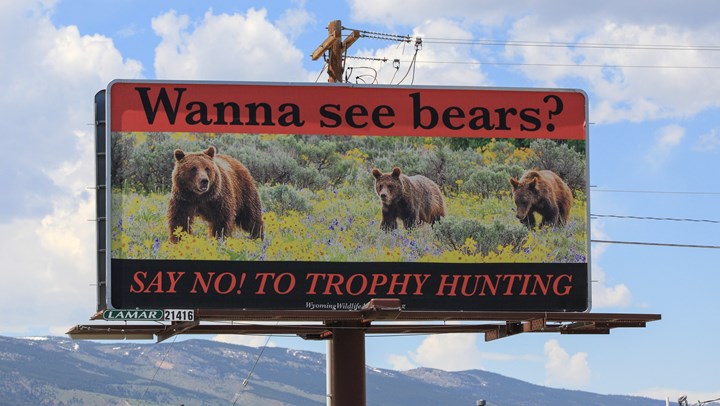
by Keith Crowely - Tuesday, June 13, 2017

Driving through Cody, Wyo., the other day I was stopped in my tracks when I saw a billboard strategically placed in front of the Wyoming Home and Ranch store on the east side of town. The billboard, paid for by a group called the Wyoming Wildlife Advocates (WWA), sends a desperate message to the vast numbers of tourists headed through Cody on their way to Yellowstone National Park.
“Wanna see bears? SAY NO! TO TROPHY HUNTING” is the bold message on the sign.
Roger Hayden, executive director of WWA, thinks the sign is perfectly situated to put across his message. Hayden was recently quoted in the Cody Enterprise saying “We like to stir up [crap], especially over there [Cody].”
While Hayden later told me the “stir sh** up” comment was “a joke,” such words merely shed more negative light on this extremist group. With the delisting of grizzly bears on the horizon, Hayden and his group of anti-hunters are making a last-ditch, hyperbolic effort at swaying public opinion against trophy hunting. Using billboards and other advertisements, groups like WWA target the general public and ignore professional wildlife managers who argue for delisting of the no-longer-endangered bears based on sound scientific knowledge rather than on politics. Reiterating his group’s stance, Hayden said we “definitely are opposed to trophy and predator hunting,” and touted, “We have one other billboard in the Bozeman area. Last year we had five in three states: Wyoming, Idaho and Montana."
As reported by the NRA Hunters’ Leadership Forum’s Karen Mehall Phillips last March, grizzly populations in the Greater Yellowstone Ecosystem (GYE) have steadily risen over the past decade with the population now estimated at more than 700 bears. According to experts at the Interagency Grizzly Bear Study Team (IGBST) and the National Park Service, the grizzly “population increased from 136 in 1975 to an estimated 717 in 2015, and the bears have gradually expanded their occupied habitat by more than 50 percent.”
The bears have begun appearing in non-traditional habitat such as agricultural areas, and even in area towns. Wildlife managers know that a carefully managed hunt is one of the few tools they have for managing the grizzly population.
Residents of Cody, Wyo., where this billboard sits, know all too well that the grizzly bear population is increasing. In the last few years, even in the last month, numerous grizzlies have been trapped in and around town and relocated to more suitable habitat. But suitable habitat is in short supply in the area and the bears, highly adaptable as they are, are spreading into areas populated by humans and livestock.
Frankly, the recovery of grizzlies is an incredible wildlife-management success story and the people and agencies like IGBST that are responsible for bringing the bears back to sustainable numbers should be left to do what they do best: Manage the population using the best available science. And the science supports delisting.
In March 2016, Dan Ashe, then Director of the U.S. Fish and Wildlife Service, issued the official USFWS position on delisting grizzlies:
“The recovery of the Yellowstone grizzly bear represents a historic success for partnership-driven wildlife conservation under the Endangered Species Act. Our proposal today underscores and celebrates more than 30 years of collaboration with our trusted federal, state and tribal partners to address the unique habitat challenges of grizzlies. The final post-delisting management plans by these partners will ensure healthy grizzly populations persist across the Yellowstone ecosystem long into the future.”
Along with the irony of the billboard being put up near federal land where hunting is not allowed, groups like WWA are well aware that grizzly populations are not “endangered” in the ecosystem anymore, but that doesn’t prevent them from tugging at the heart-strings of unsuspecting tourists heading for their once-in-a-lifetime getaway in Yellowstone National Park.
Indeed, the billboard now looking down on Cody, Wyo., appears more like a desperate, last-ditch effort to prevent the inevitable and intelligent choice of delisting. The bears are doing well—really well—in the GYE and delisting is the best possible outcome for the iconic grizzly bear.
E-mail your comments/questions about this site to:
[email protected]
